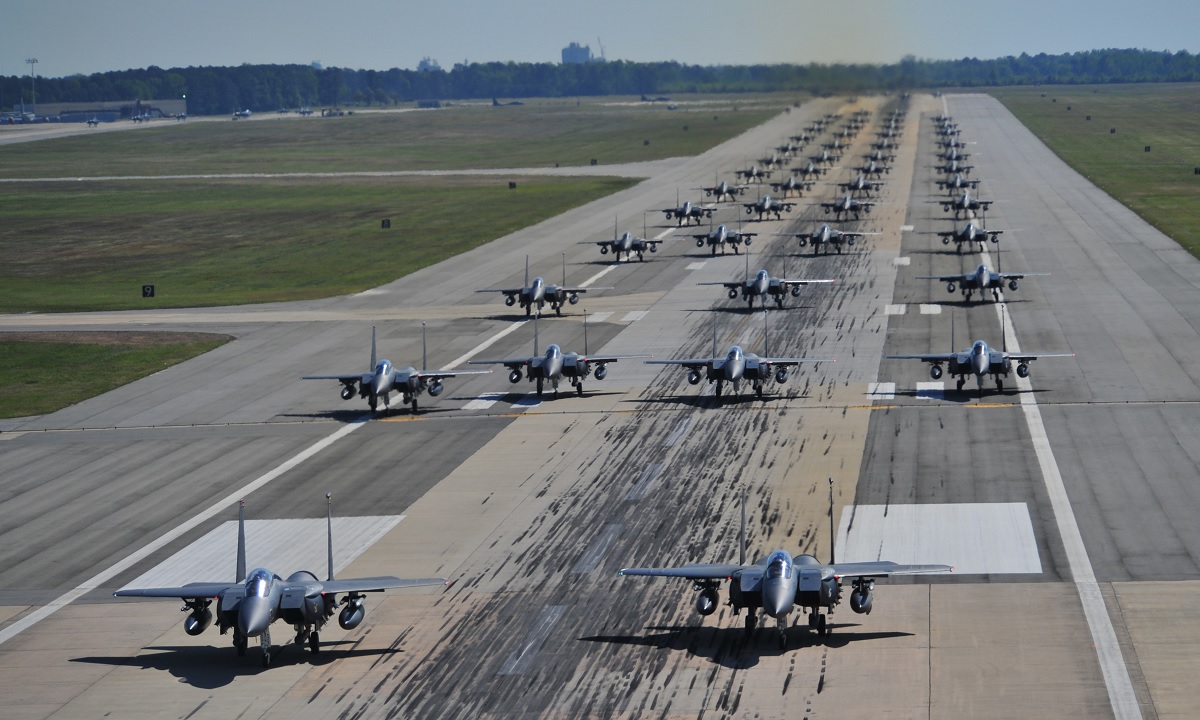The F-15E remains a fantastic and capable warfighting aircraft. It has complete power over the sky and the ground
The legendary F-15E Strike Eagle commemorated the 30th anniversary of its first flight on December 11, 2016.
The F-15E Strike Eagle, also known as the “Mudhen” by its aircrews, is still regarded by the United States Air Force (USAF) as one of its most capable multi-role, air-to-air, and air-to-ground strike fighters.
The old F-15E is nevertheless useful and capable of meeting the needs of current combatant commanders despite having flown thousands of missions during worldwide combat operations.

In his piece Strike Eagle still soars after 30 years, Airman 1st Class Kenneth Boyton of the 4th Fighter Wing Public Affairs explains how the F-15E was created as a fighter bomber with a back seat for a second crew member to operate a ground attack weapons delivery system. The most cutting-edge avionics, controls, and displays are found in the cockpit. The strengthened structure of the modified airframe enabled greater takeoff weights and doubled the lifespan of the original F-15 Eagle.
The F-15E can fly day or night, at low altitudes, and in any weather thanks to modern electronics and avionics. The aircraft is also capable of transporting almost all air-to-ground weapons available to the Air Force, such as AIM-7F/M Sparrows, AIM-9M Sidewinders, and AIM-120 advanced medium-range air-to-air missiles.
“The way the F-15E is built is a huge reason why it’s such a respected and capable aircraft,” said Maj. Michael Jokhy, 335th Fighter Squadron assistant director of operations. “The F-15E Strike Eagle can hold a lot more gas and weapons than other multi-role aircraft in our inventory.”
The Strike Eagle can stay longer where it is required and deliver more life-saving close-air support because to the extra fuel. Additionally, according to Jokhy, the extra weapons the Strike Eagle can carry are a great deterrent and serve to remind enemies that the United States wields the most powerful air force in the world.
During Operation Desert Storm in 1991, an F-15E from the 335th Tactical Fighter Squadron at Seymour Johnson Air Force Base (AFB), North Carolina, used a laser-guided bomb to destroy an Iraqi Mi-24 Hind helicopter. The F-15E also demonstrated its air-to-air and air-to-surface capabilities by repeatedly flying into hostile territory while coming under intense anti-aircraft artillery fire and destroying Scud missile installations.
During the Balkan conflict of the 1990s, the F-15E was the only fighter capable of continuously attacking ground targets in all weather conditions.
There are now 219 F-15E Strike Eagle aircraft in the U.S. Air Force, which are mostly used for close air support during operations.

As of December 2, U.S. and coalition aircraft had carried out more than 16,592 attacks in support of Operation Inherent Resolve (OIR) in Syria and Iraq, according to the Department of Defense. In support of OIR, the Strike Eagle has helped degrade and ultimately defeat the Islamic State of Iraq and the Levant by destroying or damaging more than 31,900 targets.
In order to support the DOD’s lines of effort, which include providing military support to our allies, obstructing the flow of foreign fighters, stopping ISIL’s financing and funding, and exposing ISIL’s true nature, the 335th and 336th Fighter Squadrons and maintenance units frequently deploy to areas of responsibility in Southwest Asia.
Pilots and weapons systems officers of the F-15E Strike Eagle flew more than 9,250 combat hours, dropped more than 2,000 bombs, and killed more than 80 high-value ISIL members during the most recent deployment of the 335th Fighter Squadron.
The F-15E Strike Eagles at Seymour Johnson are now receiving upgrades through the Boeing Co.’s Radar Modernization Program to further improve their already lethal capability.
“We’re doing [the upgrade] on all of the F-15E models,” said Jonathan Pierce, Boeing Co. F-15E site lead. “This radar update is going to drastically improve the aircraft’s air-to-air and air-to-ground radar, making it significantly more capable.”
The new active electronically scanned radar system, APG-82, is replacing the outdated heritage APG-70 mechanically scanned radar. It is designed to provide improved mission employment capabilities while maintaining the functioning of the previous legacy radar system.
“What I’m most looking forward to with the modification is that it will be more in line with what other fighters have across the combat Air Force,” said Capt. Bryan Hladik, 336th FS pilot. “The upgraded radar will further enhance our abilities to target [ISIL] through the weather. On days that visual acquisition of the target is not possible due to clouds, we will be able to take precise air-to-ground maps and target [Joint Direct Attack Munition] with a very high level of accuracy.”
The commander of the 4th Fighter Wing, Col. Christopher Sage, thinks the F-15E is crucial to the mission of the Air Force and to the development of combat air power.
“On its 30th anniversary, the F-15E is still a phenomenal and capable war-fighting machine. It controls the sky and dominates the ground,” said Sage. “It’s an important piece of equipment our Air Force uses to maintain air superiority in support of global operations and national defense.”

Photo by Staff Sgt. Aaron Allmon, Master Sgt. Terry L. Blevins, Staff Sgt. Elizabeth Rissmiller and Airman 1st Class Aaron J. Jenne / U.S. Air Force

